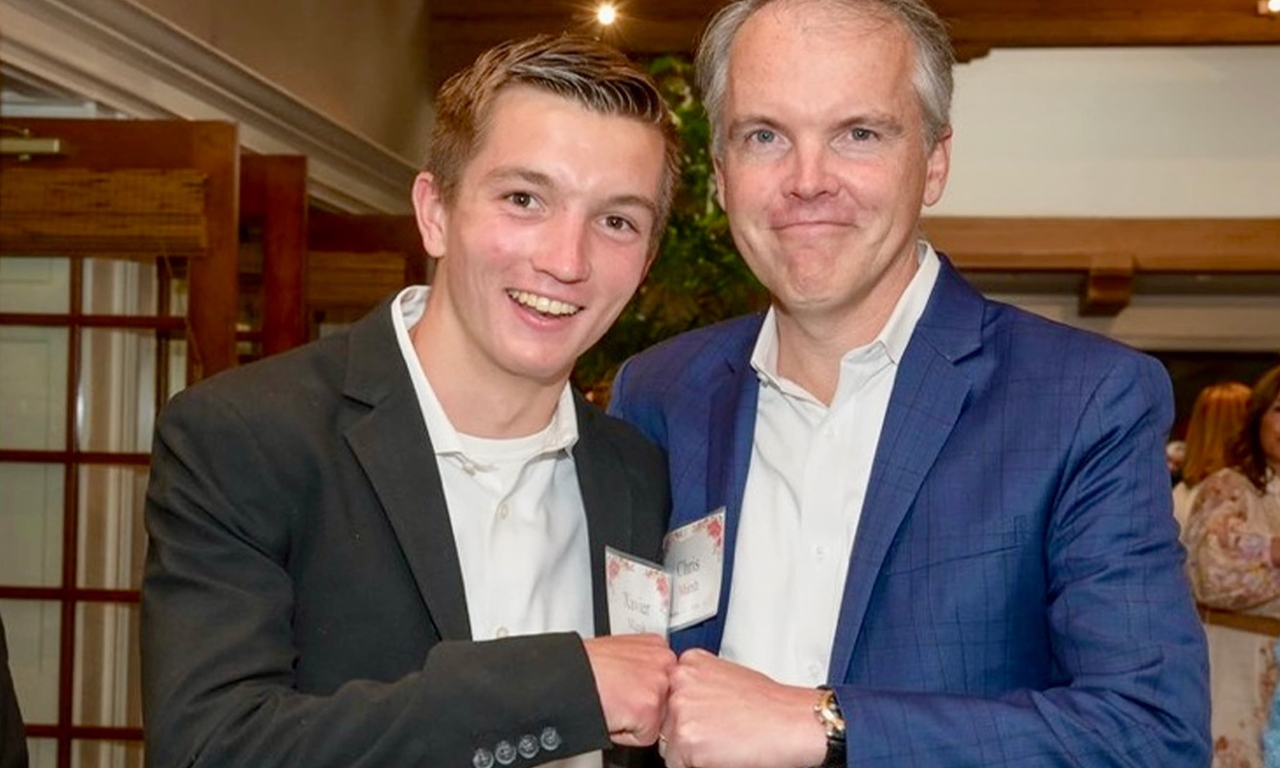Leber's Hereditary Optic Neuropathy: Xavier’s Story
Leber's Hereditary Optic Neuropathy: Xavier’s Story
Imagine having full vision, then one day losing it so quickly you don’t even have time to prepare for what your life will be like afterwards. That is exactly what happened to then 13-year-old Xavier when a routine eye exam led him and his family to discover something shocking. Because of a genetically inherited disease, Xavier would be left without his central vision in both eyes in less than three months. Now, the teen lives an extraordinary life, undeterred by the loss of his sight.
A routine eye exam

Xavier was spending the summer of 2021 like any other teenager, traveling, biking, playing video games and spending time with friends. But there were clues that trouble might be brewing with his vision. He fell a few times while mountain biking because he missed obstacles on his left side, and friends commented about gaming mistakes he made. But it was after returning to school and noticing over time that the nearby water tower was becoming harder and harder for him to see, that Xavier started to wonder what was happening to his sight.
Soon, Xavier had an appointment for glasses with an optometrist. His appointment should’ve lasted about an hour. Instead, it turned into an hours long barrage of tests, and a consultation with an ophthalmologist because Xavier couldn’t see the eye charts. His eyes looked perfectly healthy, making doctors so confused they began to think Xavier might be lying about not being able to see. At his parents’ insistence, a specialist was called in who conducted genetic testing.
When Xavier’s and his parents’ blood was tested, the results revealed that Xavier had inherited a rare permanent genetic change (mutation) called Leber hereditary optic neuropathy (LHON). He had indeed been telling the truth: He truly couldn’t see.
A diagnosis for the whole family

LHON causes a painless loss of central vision when optic nerve cells die. It leads to blindness in young adults, typically beginning between 12 - 30 years old, but can affect people who carry the gene mutation at any age. For some people with LHON, both eyes are affected at the same time. In Xavier’s case, he began to lose vision in his left eye first, triggering his brain to stop using it and rely on his right eye to compensate. He lost vision in his right eye about a month and a half later.
LHON was the first human disease discovered to be associated with a mutation in the small DNA that is exclusively inherited from a person’s mother (mitochondrial DNA or mtDNA). This significant discovery of the first mtDNA gene mutation linked to any human disease was made by Douglas Wallace, PhD, Director of the Center for Mitochondrial and Epigenomic Medicine here at Children’s Hospital of Philadelphia (CHOP).
If there is a mutation present in all copies of a mother’s mitochondrial DNA, it is inherited by all her children. For reasons that are not well understood, even though everyone in a family may carry the same LHON mutation, only a small fraction ever lose their vision. And loss of vision in individuals who carry this mutation is more common to occur in males than females.
For Xavier’s family, hearing his diagnosis meant learning that his mother, Malinda, also carries this genetic change. They now know that she and his two older brothers might also experience vision loss in the future. Malinda had to grapple with both the emotional and the logical sides of this news. “Emotionally, there was a lot of guilt to find out you are the reason your child went blind or visually impaired, and that there’s a probability your other children who currently have their vision may lose it as well. That guilt factor was significant in the initial stages. On most days now, logic prevails, and I understand this was random and not something I could have controlled.”
Breakthrough research at CHOP
After receiving an undeniable diagnosis, the next steps for the family were to contact a doctor who specializes in the study of diseases that affect the nervous system, muscles and eyes (a neuro-ophthalmologist). They found one who could see Xavier quickly at a medical center close to their home in California. But there are very few neuro-ophthalmologists experienced with this rare disease, and the family needed to know more about the mitochondrial aspect.
They traveled the country seeking mitochondrial centers of excellence. Their research led them here to CHOP and the work of Marni Falk, MD. Dr. Falk is a Clinical Geneticist and Executive Director of the Mitochondrial Medicine Program here at CHOP. Her research focuses on mitochondrial disease, including developing new treatments. Despite having to wait a few months for Xavier’s appointment, he said he felt “really lucky to have this opportunity even though it was on the East Coast."
For Xavier, the difference at CHOP versus other providers he’d seen was the level of care he received, “Many of them (providers) were like, ‘Go take these tests and bring the paper back with a signature saying they're done.’ They were not very personable. They just sent me down to wait in long lines. CHOP had a whole level dedicated to helping patients with mitochondrial diseases. Working with Dr. Falk was a lot more efficient, clear and it felt like they were trying to help me and not just send me to the next line.”
Xavier and his family committed to a full day of appointments with Dr. Falk including having their DNA tested by submitting small patches of skin, saliva and urine. Much of the testing done will help fuel the research Dr. Falk and her team are conducting to find a cure for LHON and other genetic diseases. This is something the family considers a privilege.
Malinda shared, “The research that Dr. Falk is doing is spectacular. It’s amazing to be a part of moving science forward. These types of opportunities are only available if you’re at a center of excellence such as CHOP. We all need to lean in and become active partners.”
Learning to live with LHON

When he first received his diagnosis, Xavier was in shock. But it triggered his resolve. He told his dad, Chris, “I need to learn how to live with this. You need to learn how to fix this. Now we both have our jobs.” Xavier said he felt better once he had a plan. That plan? To live his absolute best life.
Xavier has used sports and activities as his coping mechanism, continuing with Boy Scouts, rowing, varsity track, varsity cross country, skiing and surfing in the years since. The avid athlete and runner sometimes experiences things that “pop out of nowhere” when he’s running; he has hit signs and other stationary items he didn’t know were in his path. But he keeps going. While he has lost his central vision, he does maintain some blurry peripheral vision. He describes it as staticky (like a television).
As far as Chris and Malinda's job, Malinda says, “Xavier is living up to his end of the bargain. He is living his best life very intentionally. If he is going to live up to his end, we have to live up to ours.”
And they have. Xavier’s family founded a non-profit organization dedicated to accelerating progress toward a cure for LHON while improving the lives of people living with LHON. The organization provides information and resources for the newly diagnosed, creates community for those living with LHON, hosts conferences and partners with research and biopharma to help further scientific progress of this rare genetic disease.
Facing a future beyond sight
Many people with LHON can have what are called LHON “plus” (LHON+) symptoms typical of other mitochondrial diseases that affect multiple body systems (multi-systemic). These symptoms can range from becoming fatigued more easily or having tremors, to hearing issues, migraines and muscle weakness. For some, losing central vision may be the most dramatic symptom but not the only symptom. For Xavier, it is currently the only symptom.
Xavier was seen by Dr. Falk to establish a baseline of care in case additional symptoms begin to appear. While he doesn’t need continuing care for LHON+ symptoms now, he is a current patient with access to CHOP’s resources if he ever does. In explaining why this is vital access for their family, Malinda shared, “I would imagine many people come to CHOP because they’ve found out they have a mitochondrial disease and they’re looking for the expertise and partnership to live their best life. If there are resources available or medical expertise to be had, CHOP is the place where they're going to have access to those experts and the most recent clinical trials.”
In the meantime, Xavier has lots of support at home from his family and friends who have stood by him during his medical challenges. The public school system in his hometown provides two specialists to help him adapt to life with a vision impairment. A teacher for the visually impaired (TVI) helps him navigate classes, negotiate with teachers and have his best school experience. An orientation and mobility (O&M) specialist helps him navigate the world and figure out things like how to use public transportation, maps and currency.
Through it all Xavier, now in 10th grade, remains optimistic. “I like to say my eyes are still healthy. I can still see the world, but my brain isn’t processing it. For someone who is first starting out living with a mitochondrial disease, it’s important to know that it seems scary, but what we are afraid of is the unknown. Once we know we have people around us (to support us), the unknown is not so scary. Don't push away. I pushed away a bit because I wanted to find my own way and it took me a little longer. Keep your family close. Community is important.”